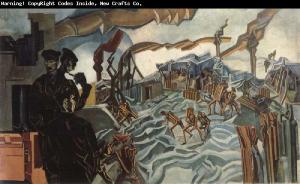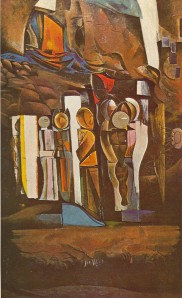Wyndham Lewis’s 1927 novel The Childermass offers an allegorical vehicle to explore an open-ended set of historical, social, political, and philosophical-theological ideas that together, in Lewis’s view, constitute a larger modernist Zeitgeist, which is not only objectionable in its content, but also, reflexively, in its propagation of its own form of historicist representation as a temporally defined phenomenon. That is, as Lewis sees it, it is a function of the conditions of modernism that it is possible at all for them to be summed up into a “spirit of the age,” pseudo-personified as a Zeitgeist, rather than characterized by otherwise: for example, geographically (“European,”North American”), politically and militarily (the “Ottoman Empire,” the Pax Romana, Ming Dynasty etc.), religiously (Buddhist, Muslim, etc.), or geographically and culturally (Hellenic, Nordic, etc.). The seemingly unshakeable temporal index that the most heterogeneous phenomena and experiences of present-day existence—allowing us to represent them as metonymies of a general condition of “modernity”—is what Lewis, in his critical polemics and his satiric fiction, hopes to estrange and hold up for scrutiny and judgment.
The Childermass presents a limbo-like world of the dead spirits of young men, many of whom have been killed in the recent trench-warfare of World War I, though according to the fluidity of time in The Childermass’s heterocosmic setting, there are also incongruous mixes of historical period, cultures, and races that are part of its world.
This setting is a mixture of a military encampment, a concentration camp (a term that Lewis actually uses, though of course not with advance knowledge of what it would come to mean), a political rally, and Roman bread-and-circuses festival. The camp is a holding area at one of the gates of the Magnetic City, where the souls will pass in and be bonded into a new collective mass.
The Magnetic City, it is suggested, is a sort of neo-London, in which all the manifestations of modernity, from collective politics to the de-differentiation of gender, will be manifest as a coherent whole. The Childermass camp is, as it were, its temporal suburb—from which we are on the threshold of passing into the Magnetic City any day. The camp is thus largely a temporal manifestation, a spatialized, allegorical dystopia of the present moment as an edge leading from recent history (World War I) to an imminent future (the coming age of collectivism). This implication is reinforced by the opening 125 pages of the book—more than a third of its total length—in which the two dead ex-soldiers and schoolboy pals Pullman and Satters wander around in the “time-flats” surrounding the camp, experiencing its strange phenomenology and manifestations. In these wanderings, Pullman has the tendency to take on traits and the idiom of James Joyce in the mode of Work in Progress (to become Finnegans Wake), which Lewis pilfered and parodied, while the corpulent, fleshy Satters can lapse into Gertrude Stein-like repetition. The two young men return to camp from their wanderings in time for the daily proceedings of the camp’s chief authority, the Bailiff, a Mefistopheles-like, Machiavellian “Old Nick” stage devil and comic villain, who also bears traits of the hysterical Roman anarch-tyrant like Heliogopolus or a brutal “oriental despot.” In this latter two-thirds of the book, Pullman and Satters becomes essentially individualized members of a chorus that reacts in stereotyped to a political and philosophical farce being staged by the Bailiff and his enemies in the camp, the hiliariously ultra-Hellenic followers of the philosopher Hyperides. The Bailiff is a classic crowd-master, while Hyperides is a hyperbolic personification of resistance to everything the Bailiff represents—a parodic, polemical grotesque by which Lewis dramatizes his ideas, not unlike his persona of “the Enemy,” while at the same time reflecting on the danger of satirical engagement: that the satirist becomes contaminated by the object of satire, or appears disfigured by the negative imprint of that which he opposes.
As I’ve noted, Lewis develops his novel around, on the one hand, a kind of magnetic flux that figuratively depicts the materialization of a qualitatively differentiated time, as envisioned by the various new philosophies of time of the early 20th century, and on the other hand, a flux of personal and collective identities, which now become subject to the vicissitudes of temporal change and variation. These two poles—which roughly correspond, as thematic “dominants”—in the two asymmetrical parts of The Childermass are mediated by flows of language, which are grammatically and stylistically affected both by the disruptive forces of temporal flux andbythe shape- and mind-shifting undermining the representational continuity that underlies characterization in the realist novel. Lewis’s novel, thus, is a tissue of effects of modernist temporality: a kind of spatialized depotentiation of modernist time, a kind of atemporal narrative map marking the bomb-craters of his explosive attacks on a myriad of individual modernist phenomena; the closest visual corollary would, in fact, be those paintings and photographs of the trench-landscape in which historical catastrophe has become so concentrated and intense as, paradoxically, to cancel any possible of organizing it as a narrative sequence. In the novelistic record of his battles, Lewis in no way negates or overcomes modernist temporality; in a certain sense his composition of The Childermass remains thoroughly parasitic upon and derivative from it. However, he does mark his difference from it through the stylized stop-motion exaggerations and grotesque distortions that remain from his aggressive satirical incursions into the modernist time-scape and its inhabitants. In his essay “What is Epic Theatre?” Walter Benjamin argued that quotation allowed gesture to come to the fore and be held up for consideration. Lewis puts quotation marks around flux and flow, and his grotesques are the product of interrupting continuous transformation and capturing processes as monstrously hybrid bodies, spaces, actions, and objects.
Let’s consider a few examples of the first sort of flux, the fluctuating phenomenological fields of the time-flats around the camp. Lewis engages a relatively simple estrangement device, to which he nevertheless steadily accretes ideological, philosophical, and aesthetic connotations: the substitution of time for space in the structuring of the object-world, bodily motion, visual appearance, and measures of proximity and distance. Thus, for example, at a certain point in their wandering, the two young men encounter an eighteenth-century English village full of miniature houses, cows the size of terriers, bush-like trees, and diminutive villagers. Besides being a nod to his precursor in philosophical and political satire, Jonathan Swift, Lewis has taken painterly perspective as a metaphor for historical distance: in this world of the dead, being two centuries past from Pullman and Satters translates into being a third of their physical height and weight. More chaotic and deranging is a passage early in the book, in which Pullman and Satters pass through a time-vortex:
The scene is redistributed, vamped from position to position intermiitently
at its boundaries. It revolves upon itself in a slow material maelstrom. Satters
sickly clings to his strapping little champion: sounds rise on all hands like
the sharp screech of ripping calico, the piercing alto of the slate-pencil, or
the bassooning of imposing masses, frictioning each other as they slowly turn
in concerted circles.
Never before have there been so many objects of uncertain credentials or
origin: as it grows more intricate Pullman whisks them forwards, peering
into the sky for lost starts twirling about as he has to face two ways at once
on the qui vive for the new setting, fearing above all reflections, on the look-
out for optical traps, lynx-eyed for threatening ambushes of anomalous times
behind the orderly furniture of Space or hidden in objects to confute the solid
at the last moment, every inch a pilot.
They get no nearer the flag-pole. Pullman alters their course. A tree is
perceived not far ahead. They reach it in determined tramp. It slips back
into the air spinning down to an impalpable thread, as a whipped top loses
body then snuffs out in a flashing spasm.
“Where did that go?” exclaims Pullman, looking round keenly.
“Over there,” cries Satters nervously, pointing to a tree.
Pullman gives it a capable glance in its new position.
A boulder entrenches itself in the path they are ascending; as they near
it it skids away in precipitate perspective to nothing. (42-43)
Lewis’s implication, however, is not just that his protagonists suffer from this disorganized time-scape. It is also that, in order to move and dwell in it, they need to adapt and adjust to it: to become more and more fluctuating time-beings, whose identity depends not on their physical, embodied, locational continuity, but rather on an asyntactical, futuristic chain of experiences and intensities “in libertà,” whose modernist literary expressions might be found in the outbursts of Marinetti’s writing, Stein’s continuous present, Joyce’s multilingual punning, Proust’s slowly thickening memories, and Pound’s transhistorical citational and stylistic montage.
Accordingly, Pullman’s and Satter’s identities flicker in and out as they pass through the time-scape, while their language blurs together with the object of Lewis’s critical parody, Joyce and Stein. Early on, Satters takes on, from time to time, the stylistic mannerisms of Stein’s “portraits”; Lewis suggests that Stein’s texts are discreditable not, as was often suggested, because they departed from representation realism in favor of cubistic fragmentation, but rather that they had mimetically assimilated as traits of style a real condition of modern subjectivity, its progressive dissolution by unstable and discontinuous time. Thus Lewis parodically represents the fluctuating nuances of feeling-tone of Satters towards his companion Pullman, in ways that also intimate the homoerotic bond between them:
Pulley has been most terribly helpful and kind, terribly kind and most
awfully helpful. He has been kind and in a sense helpful, though not so
helpful. At the start he was helpful and kind now he pushes his hand off
his arm as if he had some infectious disease, he forgets he is not alone,
but why not, if he feels horrid? He has allowed Pulley to be helpful
because he knows how kind without which he would not be worth
bothering and it is not fair to take advantage of his wish to be kind as
Pulley has. To come helping him like that was rotten if he did not
Intend to wherever they were be awfully decent as he thought he was.
Not that he minds but from the start it was understood. If Pulley did not
want to come along it was up to him; it isn’t as though he were without
experience, he should say instead of being horrid and never answering
when he spoke and thinking of himself all the time instead of understanding
just a little. He is selfish.
In burning appropriate soliloquy the first neuter show-baby hen-pecks
his dolly Pulley to himself and comes out of his nursery, with a cave-man
scowl for the rejuvenating mask at his side. The less stable ghost, to which
he has been attached, it seems, does not look at him now at all. (48)
So too, a statement by Pullman about his past, which he keeps recalling, clearly marks him as a parody of Joyce: “When war was declared I was in Trieste—in Spandau, I should say, at the Berlitz, teaching. That really got away with it and pulled me back half the time I thought I was there. It’s most remarkable how two times can be made to fit into one space and that only a functional one; no one can call this physical except by courtesy or for convenience. And it seems as natural as possible; ut trigonus in tetragono it beats the bugs!” (99).
Ultimately, however, it is the Bailiff who is the demonic figure who turns mastery of time into mastery of a new collective identity, wielding his power over the mass of souls and guiding them on their pathway into the Magnetic City, where they will be the elements of the collectivist polis and a new post-liberal politics. While his alternatingly sinister and ridiculous camp spectacle nods towards modernist references such as Conrad’s colonial outposts and Lawrence’s Kangaroo and The Plumed Serpent, it is not accidental that the Bailiff deploys Stein and Joyce as touchpoints of his political rhetoric. Thus, for example, to a Scot named Macrob who has materialized in the netherworld in a disgustingly decayed condition, the Bailiff offers a Steinian explanation of his existence:
“No one cared in the least what became of you. You happen to have
turned out as you have. The process is quite mechanical and absolutely
impartial, Space-Time got the habit of you Macrob, and threw you up
here. What after all is your history? You persisted for a certain number
of years like a stammer. You were a stammer, if you like, of Space-Time.
He—or it would be more proper to say she of the great Mother of all things”
. . . “began saying ‘Macrob’ and she went on stammering ‘Macrob’ in a
continuous present for the period of your natural life. The present “you”
is the echo of that strange event. (227-228)
At another point, the Bailiff speaks word-for-word a passage from Joyce’s Work in Progress, which can be found still in Finnegans Wake. Lewis appropriated this and other material from a borrowed manuscript for an extended interpolation in The Childermass, much to Joyce’s displeasure:
“Not so most eminent minx! Anny liffle mud which cometh out of Mam
will doob, I guess, any lithle muth outh of Mump ull doofa tha mud-gland-
washing of tha Swanee Bottom.” (174)
Like Joyce, the Bailiff deploys language as a space in which cultures, ethnicities, and historical times can intermingle fluidly and promiscuously:
“I had a man here yesterday from the Appalachian Mountains, he tried
to talk to me in Yiddish of the time of Elizabeth! I sent him over to our
Berlitz for a spell.” (256)
Ultimately, the Bailiff is a kind of personified mask of time as the continual metamorphoses, mimetism, and the exchange of simulacra. Thus, in a remarkable passage, the Bailiff enters into a sort of motion-picture superimposition—perhaps inspired by D.W. Griffith’s epic Intolerance—with his painted backdrop, depicting the Thracian Dionysus, overlaid with Wagnerian pseudo-Nordic stage-setting and Joycean references to Scandinavian literature. I would also note the suggestion of the Bailiff as an “oriental”—that is, Jewish—charlatan and stage-actor at the incongruous intersection of these mytho-poetic cultures:
He sinks back panting into the painted arms of the adolescent god of
Thrace adorning as a hackcloth the interior of his lodge, and as a few
here and there watch his honeyed collapse his person is observed to
merge in the form of the divinity. As a result it is not Swatchel but a
dark young man with a cheese-red clammy skin ornate baroque locks
of moist blue-black (but suspiciously round-shouldered if not hump-
backed), tossing a tumbled fawn-skin and chaplet of vine-leaves
superciliously (but yet remarkable for a decidedly heavy wedge of nose
far too swart arched and conspicuous), who next collides, unused to so
cramped a scene, with the narrow counter from which a cataract of
official forms falls into the court beneath as he leaps into the breach
brandishing a goblet held aloft by hand gleaming with magisterial
jewelry.
BAILIFF-BACCHUS. “Scowl!”
“Scowl!’ shortly replies the quick-witted but abashed audience
gazing tongue-tied at the reverse of the Bailiff.
The Thracian divinity skoal-drinks with dashing nordic abandon
then crashes the goblet down bottom-up, true Thracian-Norse, upon
the shelf before him. It cracks and rather slowly falls to pieces, some
parts dropping within the box and some without.
“Scowl!” Viking-Bacchus huskily repeats, but in the accents of the
vanished Bailiff. (183-184)
Thus Lewis seals his case, bringing both Stein and Joyce in proximity to the devilish Bailiff. We need not imagine that Lewis’s point is to morally castigate his modernist compatriots as the willing accomplices of the real devils who were looming up in the political landscape of the late 1920s. However, he was suggesting that modernist writing had an effective domain that was different from and separate from the direct space of political polemics and electorial campigns. In the heterocosmic spaces of these texts, in their very distance from everyday life and discourse, a consequential process was taking its course, in which the dynamics of the large society could be viewed in an estranging mirror, a liquidation of stabilities, boundaries, and edges that could once have been taken for granted. Lewis believed that it was necessary to enter these liquid spaces and stage a polarizing set of confrontations that would harden the friend-enemy relations to a situation of decision: either a final, irreversible capitulation to the forces of liquidation, or a sovereign stand to reinstitute solidities and boundaries that had been effaced.



